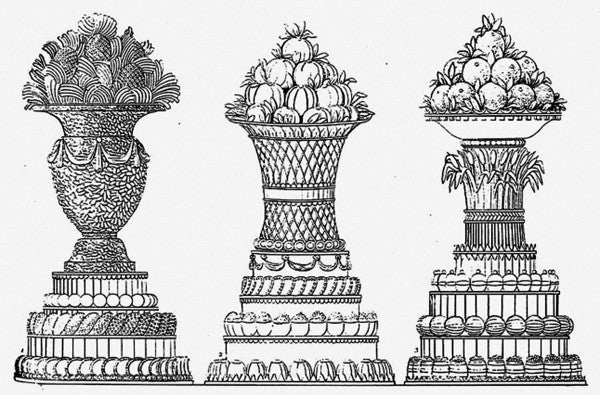
We recently released our very own version of the Croquembouche, we call it a Croquembouche Cake. We took the original concept of a Croquembouche as centre piece and added a distinctively British twist by adding cake and then a bit of our style. Along the way we did some serious research (outside of wiki!) and found out that the croquembouche has a genuinely interesting story behind it. And here in fact format you can read the highlights.
CROQUEMBOUCHE FACT 1
What is a Croquembouche? A croquembouche nowadays is a cone, widest at its base, composed of small choux pastries filled with cream and dipped in hot chocolate or more traditionally toffee. As the toffee or chocolate cools it becomes hard, brown and shiny giving the croquembouche its structure. This is often decorated with other confectionery goodies such as macarons and sugar flowers. For weddings a bride-and-groom topper is common case and for other celebrations like christenings and baptisms a smaller variation is generally prepared in a less complicated style. Each guest is served a number of choux from the main structure and a sweet before the chocolate or toffee softens.
CROQUEMBOUCHE FACT 2
Croquembouches are most popular in France and Belgium, particularly as wedding cakes where the majority of people choose them as their sweet.
CROQUEMBOUCHE FACT 3
A Croquembouche originally was a pièce montée (a decorative centre piece not necessarily edible) designed to wow your guests.
CROQUEMBOUCHE FACT 4
Croquembouches weren’t always made of choux. A recipe recounted in 1919 by Macosta tells of different kinds of Croquembouches: the Croquemboucheng Caranuain (ordinary) was made without any choux pastries but rather made with egg whites and icing sugar baked in various shapes while the Croquembouche a la Reina (Queen) used crushed sweet almonds. And in the famous Larousee Gastronomique a Croquembouche designates “all kinds of patisserie which crunches and crumbles in the mouth” and uses oranges, chestnuts or cream puffs glazed and baked to the point of cracking. Furthermore Carême’s protégé Gouffe descried a large number of croquembouches in his 1873 cookbook which did not contain any choux whatsoever, but were instead made in various shapes from fruit pastes, sugared fruits or meringues. In the picture below you are can see three very different croquembouches by Carême.

CROQUEMBOUCHE FACT 5
The present day form of the Croquembouche using choux was popularised by Marie Antoine dit Antonin Carême (1784-1833) who experimented extensively with pièce montées and famously the Croquembouche as we know it.
CROQUEMBOUCHE FACT 6
The Croquembouche is often thought of as an interactive work of art as it only truly reaches it potential in an interactive context whereby guests first visually admire it then sensually consume it.
CROQUEMBOUCHE FACT 7
Carême, an extremely well regarded and high achieving confectioner, gave the Croquembouche a nudge into eternal stardom. Carême was both an artist and an architect and used his skills to develop the Croquembouche into a full blown work of art filled with intricate detail.
CROQUEMBOUCHE FACT 8
Reshmi Bennett, a British French trained chef created the very first British Croquembouche aptly called the Croquembouche cake!

